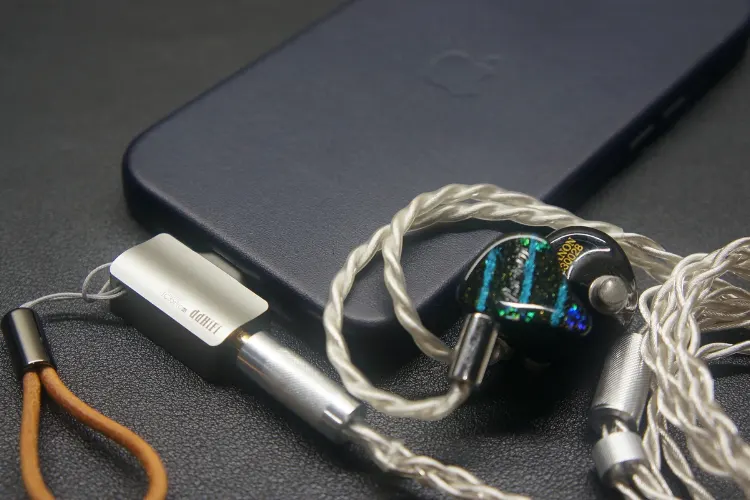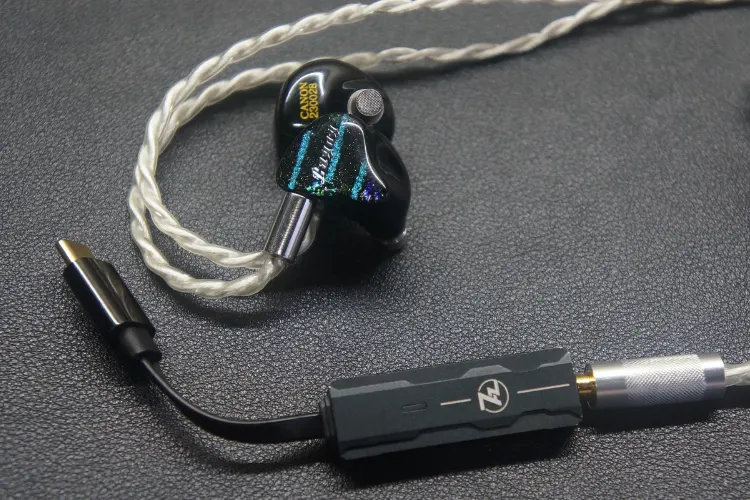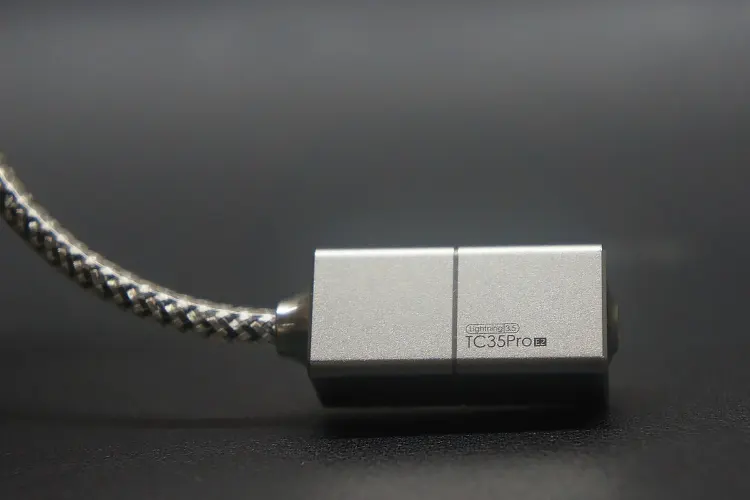Synergy
Power
Since they use the same amplifier and output design both the Ey2 and the Moutnain2 have the same rated output of 65mW into 32Ω. From a purely numbers standpoint, this is just about enough to drive harder-to-drive IEMs like the Moondrop Blessing 3 or Yanyin Canon II.
Based on my testing, I also found that it was enough to power easier-to-drive earphones such as the Koss KPH30i to a reasonable listening level without sacrificing its tonality or detail retrieval.
When it comes to harder-to-drive full-sized headphones, they can power HD 580s to a reasonable listening level, but they start to distort, and the highs become harsh and metallic sounding. I would not recommend driving full-sized 300Ω headphones with either TC35Pro 2 model.
Pairings
Based on my testing, the best pairings with the ddHiFi TC35Pro 2 are medium/hard-to-drive IEMs or easy-to-drive headphones that, on their own, feel lacking in energy or treble region detail.
Amongst the IEMs I tested, I found that the unit’s increased energy and resolution was a tad overkill with the MOONDROP Blessing 3, but also paired the best with the Yanyin Canon II and Koss KPH30i
The KPH30i can easily be driven by more affordable dongles like the 7hz SEVENHERTZ 71, but its tonality greatly benefits from treble region energy.
With my rock library, I feel that the additional upper mids energy that the TC35Pro 2 complements the warm tonality of the KPH30i with the added ability to play back electric guitars in an exciting manner.
Since the KPH30i neither comes in balanced 4.4mm, nor with a removable cable, I found that the sufficient power and additional top-end energy that the TC35Pro 2 brought in a portable form factor complimented the way I like to use the KPH30i.
Select Comparisons
7hz SEVENHERTZ 71
Technical
The TC35Pro 2 and the SEVENHERTZ 71 are built on different DAC chips. The 71 houses a single AKM AK4377 DAC chip, whilst the TC35Pro makes use of a CS43131 DAC.
Both DACs are capable of decoding PCM 32BIT/384kHz, however, the TC35Pro 2 can decode up to DSD256, while the 71 maxes out at DSD128. Both units have a single input, USB-C male for the 71 and either a lightning or USB-C male input for the TC35Pro 2. Both dongles also have a single 3.5mm SE output.
Through this output, the TC35Pro can produce up to 65+65mw @32Ω, while the more powerful 71 can drive up to 70mw @32Ω.
Design
Despite all 3 DACs falling under the “dongle” category, they still have their fair share of differences, especially the Mountain2.
Both the TC35Pro Eye2 and the 71 are constructed from 3 main parts: Input jack, cable, and dongle body. The SEVENHERTZ 71 feels like a lightweight DAC unit that hangs off a source phone or laptop. Even though the TC35Pro 2 Eye2 comes in the same form factor, its use of aluminum a denser material makes it feel more premium.
The Mountain2 on the other hand feels like an all-in-one contained unit without any cables or separate components.
Performance
The sound signatures of the 71 and the TC35Pro 2 are quite different from one another, wherein the 71 has a more prominent bass hump and is warmer in comparison.
The bass drum hits on the 71 came off as more textured and presented more nuance, and similarly can be said with strums from deep bass guitars. The TC35Pro 2 also has a slight sub-bass bump, however, this pales in comparison to the accentuated bass of the warmer 71.
The mid-range on the TC35Pro 2 is more elevated and more resolving than that of the 71. Especially when you enter the upper mids region, the sheer resolution improvement with the TC35Pro 2 becomes glaringly obvious.
The colder tonality of the TC35Pro 2 not only gives it a more prominent treble region, but it gives the overall tonality more energy than the 71 as well. Rock tracks with complex cymbal arrangements truly stand out with the TC35Pro 2, making the 71 seem slightly dull in comparison.
Sound staging is wider on the TC35pro 2, however, the 71 has better instrument separation. This tradeoff is entirely dependent on the listener, however, through my testing with the Blessing 3, Canon II, and KPH30i, I preferred the noticeably larger soundstage of the TC35Pro 2.
ddHiFi TC44pro
Technical
Both the TC44Pro and the TC35Pro 2 make use of the same DAC chip, the CS43131 DAC. However, the TC44Pro makes use of dual CS43131 DACs, while the TC35Pro 2 just makes use of one.
Because of this, both dongles have identical decoding capabilities, being able to decode up to PCM 32BIT/384kHz and up to DSD256. Both units come in either a lightning or USB-C male termination, with the TC44Pro’s sole output being a 4.4mm balanced output, and the TC35Pro 2 having a single 3.5mm SE port.
Through this output, the TC44Pro can produce up to 120mw @32Ω, while the weaker TC35Pro 2 is only able to drive up to 65+650mw @32Ω.
Design
Despite all 3 DACs falling under the “dongle” category, they still have their fair share of differences, especially the Eye2.
The TC44Pro feels like an all-in-one contained unit without any cables or separate components.
The TC44Pro and the TC35Pro Mountain2 are essentially identical, except that the TC35Pro Mountain2 is smaller in every dimension and has a 3.5mm SE output instead of a 4.4mm balanced output.
The TC35Pro Eye2’s design is more akin to a normal dongle. The attached ddHiFi 007 cable dangles the DAC chip and output jack from the USB-C or lightning jack on the other side.
Performance
To provide the fairest comparison, when testing the Yanyin Canon II and Moondrop Blessing 3, I made use of the BQEZY Winter Ultra cable that comes with detachable 3.5mm and 4.4mm connectors at the end, the 3.5mm was used to test the TC35Pro 2, and the 4.4mm was used to test the TC44Pro.
The sound signatures of the TC44Pro and TC35Pro 2 are quite similar, in no small part to the identical DAC chip used. Both dongles have the same neutral, yet cold tonality, however I observed a slight sub-bass bump with the TC35Pro 2.
The mid-range on both dongles is more elevated, however, the mids on the TC44Pro are slightly more resolving than that of the TC35Pro 2.
Both dongles have a prominent treble region, giving the overall tonality more energy. Rock tracks with complex cymbal arrangements truly stand out with the TC44 Pro.
The TC35Pro 2 can playback these instruments at a satisfactory level as well, however, the additional headroom of the TC44Pro contributes to better instrument separation.
Our Verdict
Both the ddHiFi TC35Pro Eye2 and Mountain2 are good portable dongle DACs with a balanced performance for most mid-range IEMs. Both variants have a sleek and sturdy design, a high-performance DAC chip, and an acceptable output power, with a cool but somewhat energetic tonality.
The ddHiFi TC44Pro is not perfect. Its power output level is lower than some $35 dongles, however, it does compensate with a more pleasing tonality and resolution levels.
This level of power output may be enough to drive some on-ear headphones such as the Koss KPH30i, but it is still not enough to power more demanding full-sized headphones like my HD 580 Precision.
Additionally, not having any volume controls or volume indicators can be quite annoying, however, these are minor issues that do not affect the overall performance and value of the device.
The unit’s combination of good dynamics, lightweight design, and pleasing tonality make it a decently compelling option amidst the sea of dongle DACs options, and its sound quality is well worth its price.
ddHiFi TC35Pro Eye2 Specifications
- Plug USB-C and Lightning for option
- Socket 3.5mm stereo
- DAC chips CS43131
- Amplifier Chip ES9603Q
- Output power 65mW+65mW (32Ω load)
- SNR >1225dB (A-wt)
- Cable Length 100(mm)
- Dimensions (excl. the plug) 35×14×12(mm)
- Weight 13g
ddHiFi TC35Pro Mountain2 Specifications
- Plug USB-C and Lightning for option
- Socket 3.5mm stereo
- DAC chips CS43131
- Amplifier Chip ES9603Q
- Output power 65mW+65mW (32Ω load)
- SNR >1225dB (A-wt)
- Dynamic range >120dB (A-wt)
- Dimensions (excl. the plug) 28.5×17×10.4 (mm)
- Weight 8.5g





